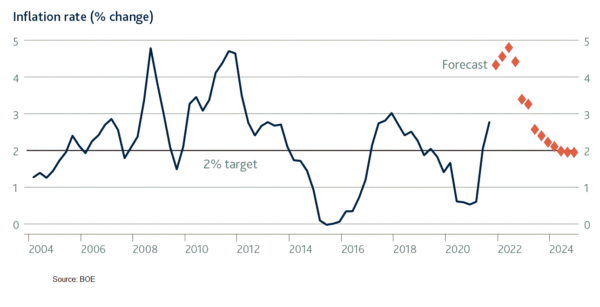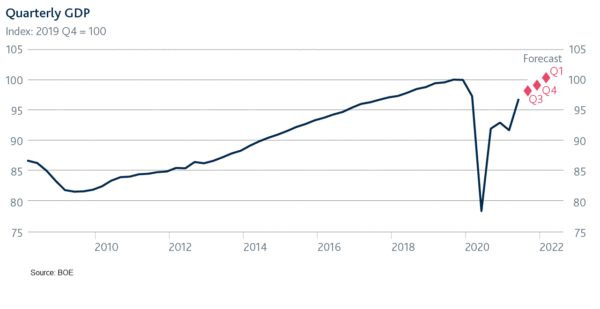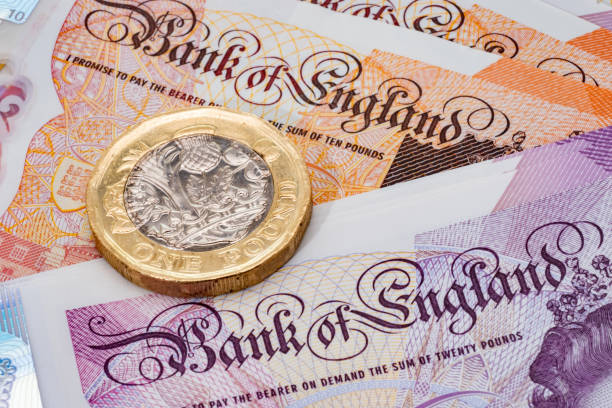Products You May Like
We were surprised that the Committee voted with overwhelming majority to leave the Bank rate at 0.1%. Despite Governor Andrew Bailey’s hawkish comments ahead of the meeting, the was one of those who voted to leave the policy rate unchanged. The BOE also decided to leave the QE program at 875B pound. On the economic outlook, the staff downgraded GDP growth forecasts while anticiapting that inflation would peak in April 2022.
Economic Outlook
As noted in the statement, the staff projected “inflation to rise to just under +4% in October, accounted for predominantly by the impact on utility bills of past strength in wholesale gas prices. CPI inflation is then expected to rise to 4.5% in November and remain around that level through the winter, accounted for by further increases in core goods and food price inflation. Wholesale gas prices have risen sharply since August”. The central bank projected that headline inflation would peak at about +5% in April 2022, driven by supply chain disruption, services inflation catch-up, and Ofgem’s increase in energy price cap. This came in “materially higher than expected in the August Report”. After that, inflation should fall in 2H22. Inflation is projected to be “a little above the +2% target in two years’ time and just below the target at the end of the forecast period”, “conditioned on the market-implied path for Bank Rate and the MPC’s current forecasting convention for future energy prices”. Policymakers estimated that the economy would return to the pre-pandemic level in 2Q22, compared with 4Q21 projected in August. Meanwhile GDP growth is expected to reach +7% this year and +5% in 2022, down from previous projection of +6%. Growth is expected to moderate sharply to +1.5% and +1% in 2023 and 2024 respectively. The downward revisions were partly attributed to the moderation in demand since the August meeting, and downside risks to demand as a result of consumer price inflation.
Policymakers estimated that the economy would return to the pre-pandemic level in 2Q22, compared with 4Q21 projected in August. Meanwhile GDP growth is expected to reach +7% this year and +5% in 2022, down from previous projection of +6%. Growth is expected to moderate sharply to +1.5% and +1% in 2023 and 2024 respectively. The downward revisions were partly attributed to the moderation in demand since the August meeting, and downside risks to demand as a result of consumer price inflation.
Policymakers attached “a high degree of uncertainty” about the near-term outlook for the labor market, after the end of the furlough scheme on September. 30. The central bank noted that “just over a million jobs are likely to have been furloughed immediately before the Coronavirus Job Retention Scheme closed at end-September, significantly more than expected in the August Report”. It added, however, that “there have continued to be few signs of increases in redundancies and the stock of vacancies has increased further, as have indicators of recruitment difficulties”.
Monetary Policy
The Committee voted 7-2 to leave the Bank rate at 0.1%. Dissenting the proposition, Dave Ramsden and Michael Saunders called for increasing the Bank Rate by +15 bps to 0.25%. Yet, it left the door open for the raising the policy rate in coming months. As noted in the statement, “the Committee judged that, provided the incoming data, particularly on the labour market, were broadly in line with the central projections in the November Monetary Policy Report, it would be necessary over coming months to increase Bank Rate in order to return CPI inflation sustainably to the 2% target”.
Meanwhile, the Committee voted 6-3 to keep the QE program at 875B pound. Dissenters Catherine Mann, Dave Ramsden and Michael Saunders all called for tapering the size of purchases to 855B pound.

